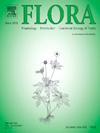Distinct morphophysiological responses of the native C4 grasses Axonopus siccus and Eragrostis polytricha to shading
IF 1.7
4区 生物学
Q3 ECOLOGY
引用次数: 0
Abstract
Light, an important abiotic factor that shapes plant growth, is explored here in its impact on two native C4 grasses of campo rupestre, an important and unique montane ecoregion in Brazil that occurs across the biomes Cerrado, Atlantic Forest and Caatinga. Axonopus siccus and Eragrostis polytricha seedlings were subjected to two light conditions: (i) artificial shading and (ii) full sun. The evaluations included growth, nutrition, photosynthesis, leaf anatomy, and metabolism. Shading influenced most of the growth parameters of E. polytricha but left A. siccus morphology almost unchanged. The parameters of leaf anatomy, nutrient content, and chlorophyll a fluorescence exhibited consistent patterns between species. In particular, A. siccus showed higher Amax and light compensation point in shaded conditions, while E. polytricha revealed distinctive changes in carbon metabolism (soluble sugars, sucrose, and starch content), explaining its increased shade growth. These findings underscore various light stress responses in these native C4 grasses.
本地 C4 草 Axonopus siccus 和 Eragrostis polytricha 对遮阳的不同形态生理反应
光照是影响植物生长的一个重要非生物因素,本文探讨了光照对鲁佩斯特雷营地(campo rupestre)两种本地 C4 禾本科植物的影响,鲁佩斯特雷营地是巴西一个重要而独特的山地生态区,横跨塞拉多、大西洋森林和卡廷加生物群落。Axonopus siccus 和 Eragrostis polytricha 幼苗在两种光照条件下生长:(i) 人工遮阳和 (ii) 全日照。评估内容包括生长、营养、光合作用、叶片解剖和新陈代谢。遮光影响了 E. polytricha 的大部分生长参数,但 A. siccus 的形态几乎没有变化。叶片解剖、营养成分和叶绿素 a 荧光等参数在不同物种之间表现出一致的模式。特别是,A. siccus 在遮荫条件下显示出更高的 Amax 值和光补偿点,而 E. polytricha 则显示出碳代谢(可溶性糖、蔗糖和淀粉含量)的独特变化,这也是其遮荫生长增强的原因。这些发现强调了这些本地 C4 禾本科植物的各种光胁迫反应。
本文章由计算机程序翻译,如有差异,请以英文原文为准。
求助全文
约1分钟内获得全文
求助全文
来源期刊

Flora
生物-植物科学
CiteScore
3.30
自引率
10.50%
发文量
130
审稿时长
54 days
期刊介绍:
FLORA publishes original contributions and review articles on plant structure (morphology and anatomy), plant distribution (incl. phylogeography) and plant functional ecology (ecophysiology, population ecology and population genetics, organismic interactions, community ecology, ecosystem ecology). Manuscripts (both original and review articles) on a single topic can be compiled in Special Issues, for which suggestions are welcome.
FLORA, the scientific botanical journal with the longest uninterrupted publication sequence (since 1818), considers manuscripts in the above areas which appeal a broad scientific and international readership. Manuscripts focused on floristics and vegetation science will only be considered if they exceed the pure descriptive approach and have relevance for interpreting plant morphology, distribution or ecology. Manuscripts whose content is restricted to purely systematic and nomenclature matters, to geobotanical aspects of only local interest, to pure applications in agri-, horti- or silviculture and pharmacology, and experimental studies dealing exclusively with investigations at the cellular and subcellular level will not be accepted. Manuscripts dealing with comparative and evolutionary aspects of morphology, anatomy and development are welcome.
 求助内容:
求助内容: 应助结果提醒方式:
应助结果提醒方式:


